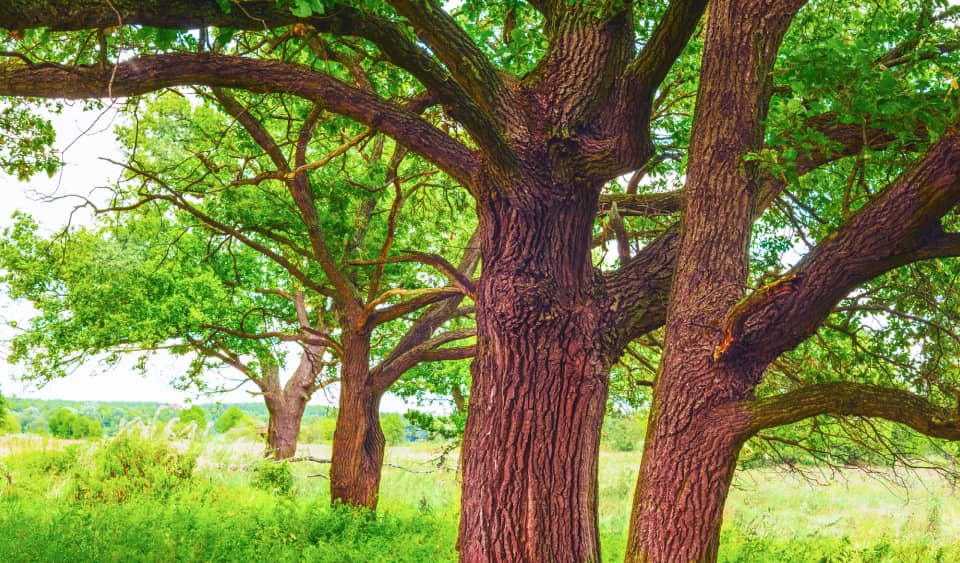
10 Fastest-Growing Trees in Oklahoma
That Thrive in Any Landscape
If you want more shade, privacy, or just a better-looking yard, planting fast-growing trees is the way to go. Oklahoma’s hot summers, unpredictable storms, and clay-heavy soil can be tough on trees, but some species grow quickly and thrive in these conditions.
Below are ten of the fastest-growing trees in Oklahoma, perfect for homeowners looking for quick results without waiting decades. Whether you want a fast-growing shade tree, a flowering tree, a drought-resistant option, or prefer evergreen trees that provide year-round greenery, there’s something here for you.
Benefits of Planting Fast-Growing Trees in Oklahoma
Planting trees isn't just about adding greenery—it’s about improving your home’s comfort and value. Here’s why fast-growing trees are a smart choice:
- Instant Shade Relief – Trees like silver maple and hybrid poplar provide quick cover, keeping your home cooler in summer.
- Natural Windbreaks – Tall, dense trees help reduce wind damage, especially in open areas.
- Privacy & Noise Reduction – A row of trees can block out neighbors and street noise.
- Wildlife Habitat – Many deciduous trees attract birds, bees, and butterflies.
- Seasonal Beauty – Some trees offer yellow fall color, while others bloom in early spring.
Fastest-Growing Trees in Oklahoma
Here are ten of the fastest-growing trees in Oklahoma that thrive in various conditions:
-
Hybrid Poplar
-
Lombardy Poplar
-
Eastern Cottonwood
-
Tulip Poplar
-
Silver Maple
-
Shumard Oak
-
Chinese Pistache
-
Bald Cypress
-
Autumn Blaze Maple
-
Lacebark Elm
Let’s go over what makes each one a great choice.

Hybrid Poplar (Populus deltoides × Populus nigra)
The Hybrid Poplar is one of the fastest-growing shade trees, shooting up 5-8 feet per year. It’s a great choice for homeowners who need quick shade, privacy screens, or windbreaks. This tree thrives in various soil types, including poorly drained soils, and adapts well to Oklahoma’s climate.
However, hybrid poplars aren’t built to last. Their lifespan is only 20-30 years, and they can develop weak, brittle branches that break in storms. Despite this, they’re a great temporary solution for those wanting fast results.
PROS:
- Grows extremely fast (5-8 feet per year)
- Ideal for shade, privacy, and windbreaks
- Adapts to different soil conditions
- Low maintenance once established
- Provides quick landscaping solutions
CONS:
- Short lifespan (20-30 years)
- Weak branches prone to breakage
- Susceptible to pests and diseases
Lombardy Poplar (Populus nigra 'Italica')
If you need instant privacy, the Lombardy Poplar is an excellent option. It grows 6+ feet per year and has a narrow, columnar shape, making it perfect for lining driveways or acting as a windbreak. This tree handles drought conditions well and thrives in Oklahoma’s climate.
However, Lombardy poplars have a short lifespan (15-25 years) and are prone to canker disease, which can weaken them over time.
PROS:
- Extremely fast-growing
- Great for windbreaks and privacy screens
- Tolerates drought conditions
- Narrow shape makes it ideal for small spaces
- Easy to maintain once established
CONS:
- Short lifespan (15-25 years)
- Prone to canker disease
- Requires regular maintenance to stay healthy
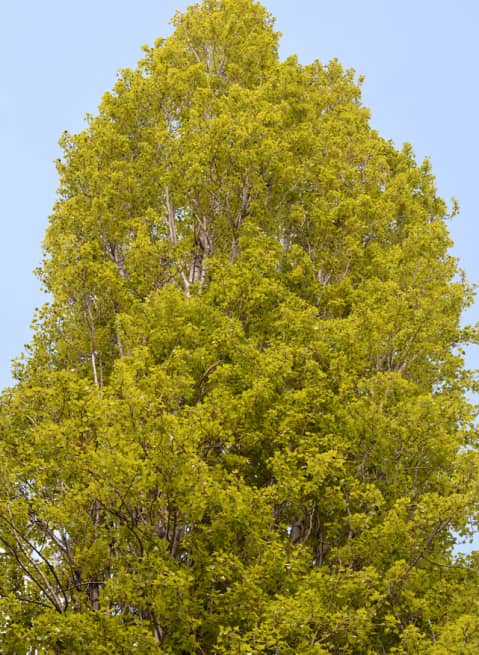

Eastern Cottonwood (Populus deltoides)
A native Oklahoma tree, the Eastern Cottonwood is a fast-growing shade tree that reaches 60-100 feet tall. It thrives in wet conditions and is commonly found near rivers and lakes. This tree grows 5-7 feet per year, making it one of the best options for quick shade.
However, cottonwood trees can be messy, dropping fluffy white seeds in late spring. Their wood is also weak, making them prone to storm damage.
PROS:
- Native to Oklahoma—thrives in local conditions
- Provides rapid shade
- Ideal for poorly drained soils and wet areas
- Great for preventing erosion
- Attracts wildlife
CONS:
- Messy due to cotton-like seeds
- Weak branches prone to breaking in storms
- Not ideal for small yards
Tulip Poplar (Liriodendron tulipifera)
The Tulip Poplar is a large tree with a rapid growth rate, adding 3-5 feet per year and providing excellent shade as it matures.
It produces tulip-shaped yellow flowers in early spring, making it one of the most beautiful flowering trees in Oklahoma. It grows tall (70-90 feet) and develops a rounded crown, making it a great addition to large yards.
Tulip Poplars, also known as Tulip Trees, require well-drained soil and regular watering. They don’t have strong drought tolerance, so they’re best suited for homeowners who can provide consistent moisture.
PROS:
- Beautiful yellow flowers in early spring
- Fast-growing shade tree with strong wood
- Provides yellow fall color
- Long lifespan (100+ years)
- Attracts pollinators
CONS:
- Needs well-drained soil
- Not drought-tolerant
- Requires regular watering
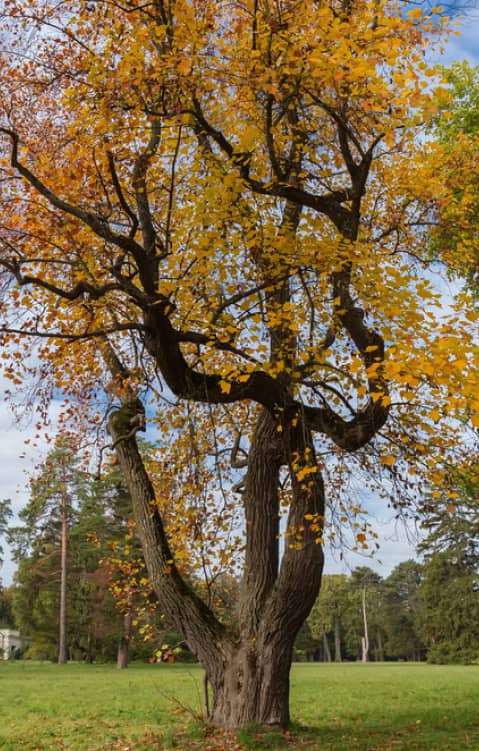
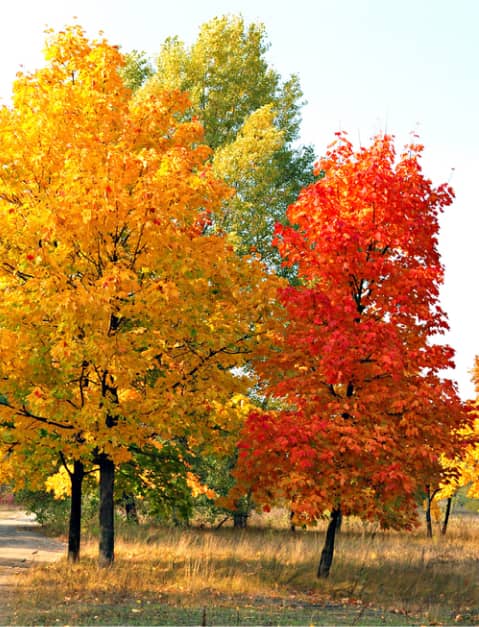
Silver Maple (Acer saccharinum)
The Silver Maple is a fast-growing shade tree that reaches 50-80 feet tall. It grows 3-5 feet per year, thrives in urban settings, and adapts to poorly drained soils. Its dark green leaves turn yellow in fall, adding seasonal beauty to any landscape.
However, silver maples have weak wood, making them prone to storm damage. Their roots are also aggressive, so they should be planted away from foundations and sidewalks.
PROS:
- Fast-growing shade tree
- Tolerates wet conditions and poor soils
- Attractive dark green foliage
- Provides quick shade
- Adaptable to urban environments
CONS:
- Weak branches that snap easily
- Invasive roots can damage sidewalks
- Requires frequent pruning
Shumard Oak (Quercus shumardii)
The Shumard Oak is one of the fastest-growing oak trees, adding 2-4 feet per year and reaching 40-60 feet tall. Unlike many other fast-growing trees, it has strong wood and can withstand harsh weather conditions, including drought and heavy winds.
With its rounded crown and deep root system, it’s an excellent long-term investment for homeowners looking for shade and durability.
In fall, the Shumard Oak puts on a stunning display, with attractive red and orange leaves that enhance the landscape with seasonal beauty. It’s also highly drought-resistant once established, making it one of the best shade trees for Oklahoma.
PROS:
- Fast-growing oak tree with strong wood
- Thrives in both wet and dry conditions
- Beautiful red-orange fall color
- Drought-resistant once mature
- Long lifespan (100+ years)
CONS:
- Needs plenty of space to grow
- Requires regular pruning when young for strong structure
- Can take time to establish deep roots


Chinese Pistache (Pistacia chinensis)
The Chinese Pistache is a drought-tolerant, fast-growing shade tree, reaching 35-50 feet tall. It starts off growing slowly, but after a few years, it gains speed, adding 2-4 feet per year. This tree thrives in hot, dry conditions, making it a great option for Oklahoma’s scorching summers.
One of its biggest highlights is its fall foliage, which turns brilliant red, orange, and yellow. The Chinese Pistache is also resistant to pests and diseases, requiring little maintenance once established.
PROS:
- Highly drought-tolerant
- Gorgeous red, orange, and yellow fall colors
- Resistant to pests and diseases
- Thrives in poor soil conditions
- Requires little maintenance once established
CONS:
- Slow-growing in its first few years
- Requires pruning for a strong shape
- Can drop small fruits that some homeowners find messy
Bald Cypress (Taxodium distichum)
The Bald Cypress is a unique deciduous conifer, meaning it drops its needles in winter. It grows 2-4 feet per year and can reach 50-70 feet tall. It’s well-known for its ability to thrive in both wet and dry conditions, making it a great option for areas with poorly drained soils or near rivers and lakes.
Unlike some other fast-growing trees, the Bald Cypress has strong, durable wood that resists storm damage. Its dark green foliage turns rusty orange in fall, creating a striking seasonal display.
PROS:
- Long-lived and durable
- Thrives in both wet and dry conditions
- Beautiful fall color with orange-brown needles
- Resistant to storms, pests, and diseases
- Strong wood, making it great for wind-prone areas
CONS:
- Drops needles in winter
- Slower growth compared to poplars and maples
- Prefers moist soil but can adapt to drier conditions
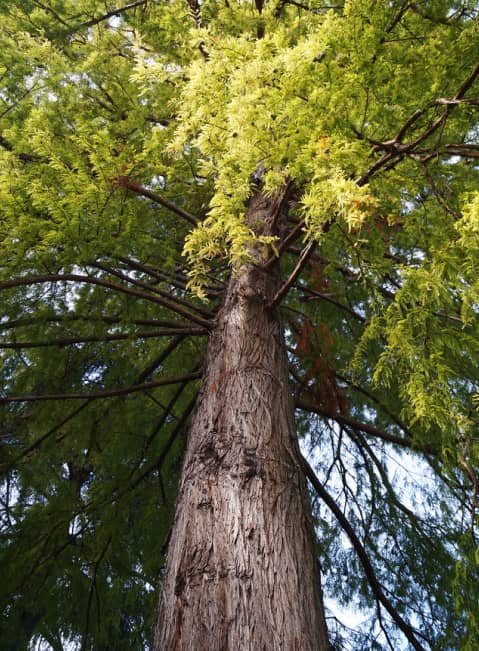
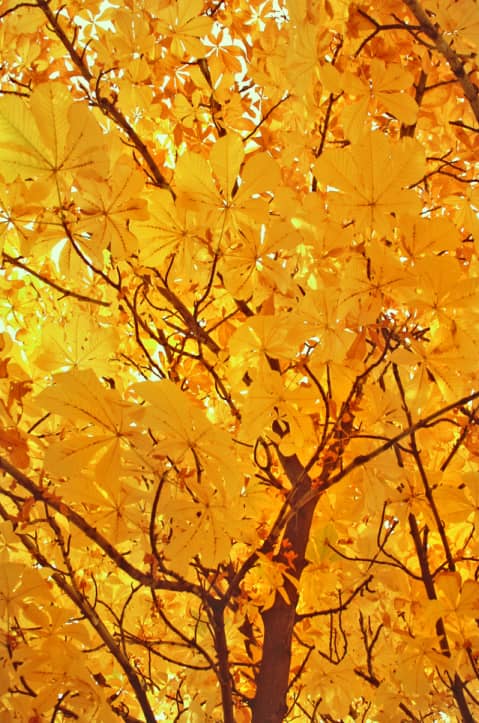
Autumn Blaze Maple (Acer × freemanii)
The Autumn Blaze Maple is a fast-growing hybrid of the Silver Maple and Northern Red Oak, similar to the October Glory Maple, which is also known for its vibrant fall color and rapid growth.
It grows 3-5 feet per year and reaches 40-50 feet tall, making it one of the best fast-growing shade trees for Oklahoma.
This tree is prized for its stunning fall color, turning a brilliant red-orange in autumn. It thrives in well-drained soil and adapts well to urban environments, though it does require occasional pruning to maintain its structure.
PROS:
- Fast-growing shade tree (3-5 feet per year)
- Stunning red-orange fall color
- Stronger wood than Silver Maple
- Adapts to urban conditions
- Drought-tolerant once established
CONS:
- Needs moist, well-drained soil for best growth
- Can snap in strong winds if not pruned properly
- May require extra watering in dry periods
Lacebark Elm (Ulmus parvifolia)
The Lacebark Elm is a hardy, fast-growing tree, adding 3-4 feet per year and reaching 40-50 feet tall. It is highly resistant to Dutch elm disease, making it one of the best choices for urban and suburban landscapes. Its exfoliating bark provides year-round visual interest, making it a great ornamental shade tree.
This tree is drought-tolerant and adapts well to poor soil conditions, including poorly drained soils. With its rounded crown, it provides plenty of shade, making it a practical and attractive option for Oklahoma yards.
PROS:
- Fast-growing shade tree
- Highly resistant to Dutch elm disease
- Drought-tolerant and adaptable to poorly drained soils
- Unique exfoliating bark for year-round beauty
- Requires minimal maintenance
CONS:
- Shallow roots can be prone to uprooting in storms
- Can develop multiple trunks if not pruned properly
- May require occasional trimming to maintain shape
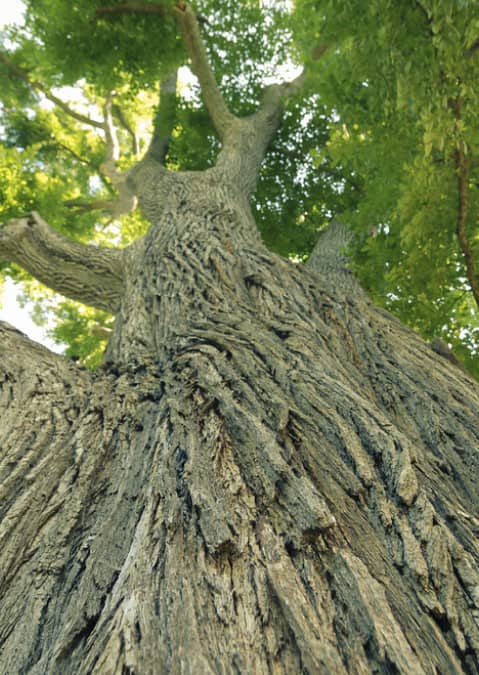
Factors to Consider When Choosing a Fast-Growing Tree
Fast-growing trees can be a great addition to your yard, but not every tree is right for every location. Before planting, consider these key factors to make sure your tree thrives and doesn’t become a headache later.
Soil Type and Drainage
Some trees thrive in well-drained soil, while others handle poorly drained soils better. Eastern Cottonwood and Bald Cypress do well in wetter areas, whereas Chinese Pistache and Shumard Oak prefer drier, more compact soils.
If your yard tends to flood or retain water after heavy rains, picking a tree that tolerates wet conditions is a must—trees like the River Birch are well-suited for these environments.
On the flip side, if you live in a dry, sandy area, you’ll want a drought-resistant species like the Chinese Pistache or Desert Willow, both of which thrive in hot, dry conditions.
Sunlight and Shade Preferences
Not all trees need full sun to grow quickly. While Hybrid Poplar and Silver Maple grow best in full sun, others, like Lacebark Elm, can handle partial shade.
Before planting, consider how much sunlight your yard gets throughout the day. Placing a full-sun tree in a shaded spot will slow its growth and make it more vulnerable to disease.
Maintenance and Pruning Needs
Fast-growing trees often come with maintenance requirements, especially those with weak wood, like Silver Maple and Lombardy Poplar. Some trees need regular pruning to keep them structurally sound and prevent breakage in high winds.
Others, like Chinese Pistache, require early shaping to develop a strong structure. If you want a low-maintenance tree, go for something with strong wood, like Shumard Oak or Bald Cypress.
Lifespan and Long-Term Care
Some fast-growing trees are short-lived, while others last a lifetime. Hybrid Poplar and Lombardy Poplar grow at record speeds but only live 20-30 years.
If you want a tree that sticks around for generations, opt for Shumard Oak, or Lacebark Elm, which can live for 100+ years. A little patience can go a long way if you're looking for something permanent.
Common Challenges with Fast-Growing Trees
Fast-growing trees are great for quick shade and privacy, but they come with a few trade-offs. Here are some common challenges to be aware of:
- Weak Wood & Storm Damage – Trees like Silver Maple and Cottonwood grow quickly but have brittle branches that break easily in high winds.
- Short Lifespan – Some trees, like Hybrid Poplar and Lombardy Poplar, grow fast but only last a couple of decades before declining.
- Invasive Roots – Trees like Silver Maple and Cottonwood have aggressive roots that can damage sidewalks, driveways, and even sewer lines.
- Messy Droppings – Some fast-growing trees, like Cottonwood, drop large amounts of seeds, leaves, or sap that can be a hassle to clean up.
- Pest & Disease Issues – Many fast growers are more prone to pests and diseases, requiring extra care and attention to keep them healthy.
When to Plant Trees in Oklahoma?
The best time to plant trees in Oklahoma is fall (September to November) or early spring (February to April) when temperatures are mild, allowing roots to establish before extreme weather. Fall is ideal since trees are dormant, reducing transplant shock.
Early spring works well for flowering trees like Tulip Poplar and Oklahoma Redbud, but regular watering is needed to handle summer heat.
Avoid mid-summer planting, as high temperatures stress young trees, and late winter, when sudden freezes can cause damage. Planting at the right time helps trees grow strong and healthy.
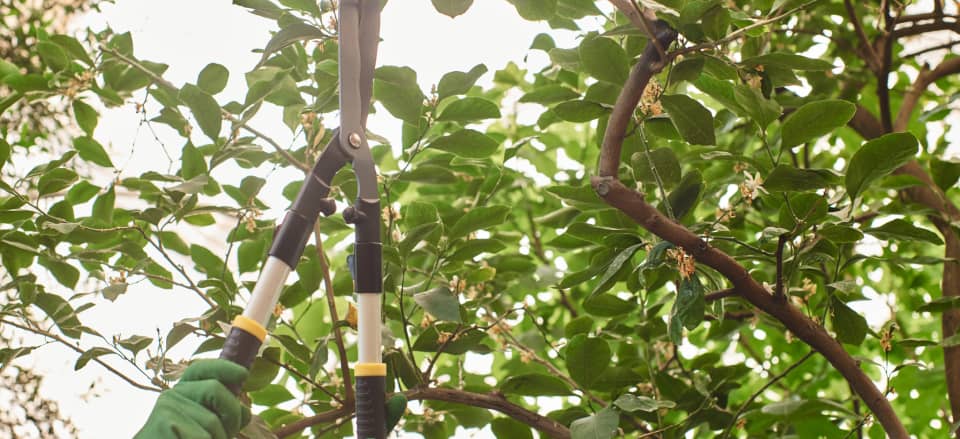
How to Care for Trees That Grow Fast in Oklahoma
Fast-growing trees need proper care to thrive and avoid structural issues. Planting them in the right location, providing consistent water, and regular pruning will keep them strong and healthy.
-
Watering: Newly planted trees need deep, consistent watering, especially in the first few years. Trees like Bald Cypress thrive in poorly drained soils, while Shumard Oak prefers well-drained soil to prevent root rot.
-
Pruning: Fast-growing trees like Silver Maple and Lombardy Poplar can develop weak branches, and without proper pruning, the tree’s roots may struggle to support their mature size, increasing the risk of storm damage. Regular trimming strengthens the tree and prevents damage.
-
Fertilization: Some trees need extra nutrients to support rapid growth. A balanced fertilizer with nitrogen, phosphorus, and potassium can help build strong roots and healthy foliage.
-
Pest & Disease Control: Many fast-growing trees are prone to fungal infections, cankers, and insect infestations. Regular inspections and early treatment prevent serious damage.
-
Soil Considerations: Make sure the tree matches your soil type. Cottonwood and Bald Cypress handle poorly drained soils, while Chinese Pistache and Shumard Oak need well-drained soil to stay healthy.
Trees to Avoid: Fast-Growing but Problematic
Some trees grow fast but come with more problems than they’re worth. These trees might have weak wood, invasive roots, or a short lifespan, making them less than ideal for Oklahoma homeowners.
If you’re considering planting a fast-growing tree, here are some to think twice about:
- Bradford Pear – Beautiful in spring, but prone to splitting and has a short lifespan.
- Mimosa Tree – Attractive flowers, but weak wood and highly invasive.
- Siberian Elm – Grows quickly but is messy, brittle, and attracts pests.
- Tree of Heaven – Fast-growing but invasive, spreading aggressively and choking out native plants.
- Willow Trees (Weeping Willow, Desert Willow, etc.) – Gorgeous but prone to disease and weak branches that snap easily.
While these trees may seem like good choices at first, their long-term maintenance and structural issues make them more of a hassle than a benefit.
Conclusion
Planting Oklahoma’s fastest-growing trees are great way to add shade, privacy, and beauty to your yard—without waiting decades.
Whether you choose a Shumard Oak for longevity, an Autumn Blaze Maple for brilliant fall color, or a Bald Cypress for durability, picking the right tree for your landscape makes all the difference.
When choosing a tree, consider soil type, sunlight, maintenance needs, and lifespan. Avoid trees with weak wood or invasive roots, and focus on species that thrive in Oklahoma’s climate. With the right care, your tree will grow strong and provide benefits for years to come.
Looking for professional tree advice? TREES BY JAKE offers expert tree assessments, maintenance, and removal services in Oklahoma. Contact us today to keep your trees healthy and your property safe!
Frequently Asked Questions
-
What tree has the fastest growth rate?
The Hybrid Poplar is one of the quickest-growing trees in Oklahoma, adding 5-8 feet per year. It’s a great option for those needing quick shade or a windbreak, but it has a shorter lifespan than other trees.
-
Which tree gives maximum shade?
Large, wide-canopy trees like Silver Maple, Shumard Oak, and Bald Cypress provide dense shade, making them ideal for cooling down yards and protecting other plants from excessive sun exposure. These trees grow tall with broad crowns, making them ideal for cooling down yards and reducing energy costs.
-
What is the fastest-growing tree for shade?
The Silver Maple is one of the fastest-growing shade trees, adding 3-5 feet per year. It grows quickly and provides a broad canopy, but it has weak branches that require regular pruning.
-
What is the best oak tree to plant in Oklahoma?
The Shumard Oak is the best oak tree for Oklahoma. It grows 2-4 feet per year, thrives in well-drained soil, and provides long-lasting shade. It’s also drought-tolerant once established.
-
How fast do pine trees grow in Oklahoma?
Most pine trees in Oklahoma, like Loblolly Pine and Eastern White Pine, grow about 1-2 feet per year. While slower than poplars or maples, these evergreen trees provide year-round greenery, making them a great choice for long-term shade and wind protection.
-
What is the best shade tree for Oklahoma?
The Shumard Oak is one of the best shade trees for Oklahoma because it’s fast-growing, strong, and long-lived. It provides a dense canopy and thrives in both wet and dry conditions, making it a reliable choice.
-
Which privacy tree grows the fastest?
The Lombardy Poplar grows 6+ feet per year and is one of the best fast-growing trees for privacy screens and windbreaks. Its tall, narrow shape makes it ideal for lining property edges.
-
Which flowering tree grows fast in Oklahoma?
The Tulip Poplar is one of the fastest-growing flowering trees, growing 3-5 feet per year. It produces beautiful yellow flowers in early spring and provides great shade. The Oklahoma Redbud Tree, a native species, is another fast-growing choice, offering stunning pink-purple blooms in spring and thriving as both an ornamental tree and a street tree in urban settings.
Contact Your
Tulsa Tree Service
TREES BY JAKE has been providing tree removal services in Tulsa for over a decade. Jake is a Tulsa Certified Arborist and we have a variety of equipment to safely and efficiently remove trees. Call or text us today for your free estimate at 918-500-9955 and don’t forget to check us out on Facebook, Instagram, and Twitter!